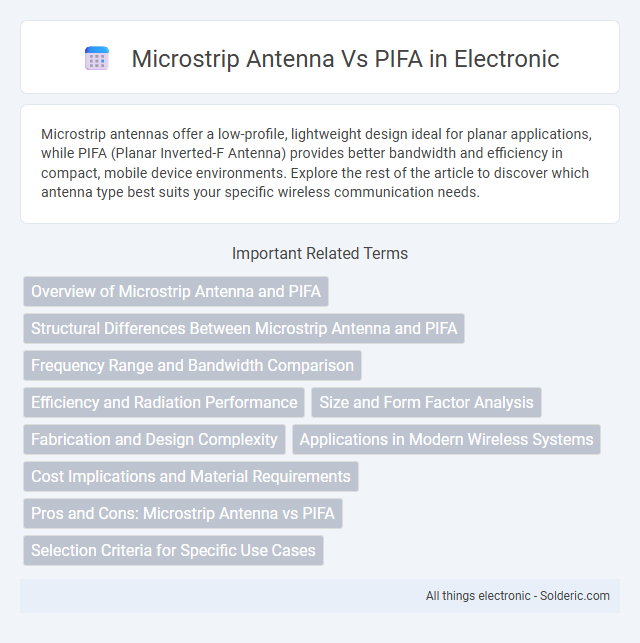Microstrip antennas offer a low-profile, lightweight design ideal for planar applications, while PIFA (Planar Inverted-F Antenna) provides better bandwidth and efficiency in compact, mobile device environments. Explore the rest of the article to discover which antenna type best suits your specific wireless communication needs.
Comparison Table
| Feature | Microstrip Antenna | PIFA (Planar Inverted-F Antenna) |
|---|---|---|
| Structure | Flat metal patch on dielectric substrate over ground plane | Shorted microstrip patch with one edge connected to ground |
| Size | Moderate size; depends on frequency and substrate | Smaller, compact size suitable for mobile devices |
| Bandwidth | Narrow to moderate bandwidth (a few %) | Wider bandwidth compared to standard microstrip antenna |
| Gain | Moderate gain (5-7 dBi typical) | Lower gain but adequate for handheld devices |
| Polarization | Mostly linear polarization | Linear or circular polarization depending on design |
| Applications | Satellite communication, radar, WLAN | Mobile phones, RFID, compact wireless devices |
| Fabrication | Simple, low cost planar fabrication | Requires precise shorting pin or strip; slightly complex |
| Impedance Matching | Usually requires external matching network | Intrinsic impedance matching via shorting element |
Overview of Microstrip Antenna and PIFA
Microstrip antennas consist of a flat rectangular metallic patch on a grounded substrate, offering low profile, lightweight design, and ease of fabrication, ideal for wireless communication systems. Planar Inverted-F Antennas (PIFA) feature a shorted patch element with a ground plane, providing compact size, wide bandwidth, and better impedance matching in mobile devices. Understanding the structural differences helps optimize your antenna choice for specific applications like smartphones or IoT devices.
Structural Differences Between Microstrip Antenna and PIFA
Microstrip antennas feature a flat, planar rectangular or circular patch placed over a ground plane with a dielectric substrate, enabling low-profile and lightweight designs. Planar Inverted-F Antennas (PIFA) incorporate a shorting plate or pin connecting the patch to the ground plane, reducing antenna size and improving bandwidth and impedance matching. Structural variations such as the presence of the shorting element in PIFA result in more compact form factors compared to the larger, substrate-dependent microstrip antenna configurations.
Frequency Range and Bandwidth Comparison
Microstrip antennas typically operate efficiently within the microwave frequency range from 1 GHz to 100 GHz, offering moderate bandwidths around 2-5%, making them suitable for narrowband applications. Planar Inverted-F Antennas (PIFA) are optimized for mobile and wireless communication systems, functioning effectively within 800 MHz to 2.6 GHz and providing wider bandwidths, often exceeding 10%, which supports better multi-band and broadband performance. The choice between microstrip antennas and PIFA depends significantly on the required frequency range and bandwidth, with PIFA generally preferred for broader bandwidth and lower-frequency applications.
Efficiency and Radiation Performance
Microstrip antennas offer moderate efficiency due to their planar structure but often suffer from lower radiation efficiency caused by substrate losses and surface wave excitation. In comparison, Planar Inverted-F Antennas (PIFA) exhibit higher radiation efficiency and better performance in compact, low-profile designs, making them ideal for mobile and portable applications. Your choice depends on the need for higher gain and efficiency, where PIFA generally outperforms microstrip antennas in radiation characteristics.
Size and Form Factor Analysis
Microstrip antennas typically feature a low-profile, planar form factor with smaller overall dimensions, making them ideal for compact and lightweight applications. PIFA (Planar Inverted-F Antenna) designs offer an even more reduced size by incorporating a shorting pin or plate, which enables resonance at lower frequencies within a smaller footprint. The compactness and ease of integration of PIFA make it preferable for mobile devices, while microstrip antennas provide design flexibility for varied frequency bands and substrate materials.
Fabrication and Design Complexity
Microstrip antennas feature a simpler fabrication process using flat conductive patches on a dielectric substrate, allowing for easy mass production and low-cost manufacturing. PIFA (Planar Inverted-F Antenna) designs are more complex due to the incorporation of a shorting pin or strip, which requires precise tuning and assembly to achieve optimal performance. Your choice depends on design complexity tolerance and fabrication budget, as microstrip antennas offer straightforward production while PIFA demands more intricate manufacturing steps.
Applications in Modern Wireless Systems
Microstrip antennas are widely used in satellite communication, GPS devices, and mobile phones due to their low profile and ease of integration with printed circuit boards. Planar Inverted-F Antennas (PIFA) are preferred in compact wireless devices such as smartphones and IoT sensors because of their better bandwidth efficiency and reduced size. Both antenna types enable advanced wireless systems by supporting high-frequency operation and facilitating seamless connectivity in modern communication infrastructures.
Cost Implications and Material Requirements
Microstrip antennas generally incur lower manufacturing costs due to their simpler PCB fabrication processes and use of standard dielectric substrates like FR4, making them attractive for mass production. PIFA (Planar Inverted-F Antenna) designs require more complex assembly with additional components such as ground planes and shorting pins, which can increase material expenses and labor time. Material requirements for PIFA often involve higher-quality substrates or metals to maintain performance in compact form factors, influencing overall cost compared to microstrip antennas.
Pros and Cons: Microstrip Antenna vs PIFA
Microstrip antennas offer low profile, ease of fabrication, and integration with printed circuit boards but suffer from narrow bandwidth and lower efficiency compared to PIFA. PIFA (Planar Inverted-F Antenna) provides improved bandwidth and better performance in compact mobile devices due to its ground plane coupling and shorter antenna length. However, PIFAs can be more complex to design and may require more space than microstrip antennas in certain applications.
Selection Criteria for Specific Use Cases
Microstrip antennas offer compact size and planar structure, making them ideal for lightweight, low-profile applications such as satellite communication and wearable devices. PIFA antennas excel in mobile and handheld devices due to their enhanced bandwidth, better impedance matching, and reduced susceptibility to detuning from the human body. Selection between microstrip and PIFA antennas depends on factors like operating frequency, space constraints, radiation pattern requirements, and environmental interference tolerance.
microstrip antenna vs PIFA Infographic

 solderic.com
solderic.com